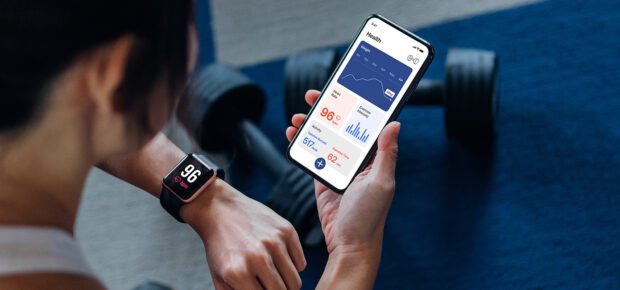May 12, 2022
For anyone who has worn a fitness tracker, there’s probably one question they have in the back of their minds: just how accurate are they?
Long story short, say the experts, they can help indicate when you should go see a doctor, but they aren’t a substitute for a trained medical professional.
“There is nothing that is a substitute for a well-experienced cardiologist in a hospital setting with their hospital grade equipment,” said IEEE Member Carmen Fontana, who began using the earliest heart rate monitors as a college athlete in the ‘90s, and now uses a fitness watch to monitor a genetic heart condition discovered in recent years. “These devices we wear on our wrists now are pretty darn good. Where they are beneficial to you and your cardiologist is it allows continuous monitoring. You can’t be in the lab 24/7. While they might not be medical grade, they do a great job of being a first line of defense.”
A handful of fitness trackers are marketed as ECG watches –– ECG standing for electrocardiogram. The distinction between a fitness tracker and an ECG watch is that the latter has received a level of regulatory clearance to monitor for certain conditions. In the U.S., for example, that’s usually the Food and Drug Administration.
But the clearance may not extend to all cardiac conditions. The most common conditions that ECG watches are cleared to monitor for is a type of irregular heartbeat known as atrial fibrillation. But the watches are not approved to monitor for other conditions. That means that the patient will still require further testing by a medical professional using a 12-lead professional ECG in a hospital.
“The traditional 12-lead ECG can measure the overall magnitude of the electrical potentials of the heart,” said IEEE Member Eros Pasero, “Some smartwatch models can provide important information about atrial fibrillation and other important cardiovascular diseases. This information can require an additional full ECG.”
The question of accuracy in smartwatches and fitness trackers, however, continues to draw continued research interest, with hundreds of trials using some of the most popular fitness devices. The most reliable answers, as reported in IEEE Pulse, are systematic reviews that examine multiple assessments.
Learn more:
Engineers and technologists are exploring numerous ways to integrate smartwatches and other wearable devices into mission-critical applications for health and safety. In IEEE, the world’s foremost researchers provide several examples, including detecting when people are too sleepy to drive, and when workers in healthcare or food preparation have or haven’t washed their hands properly.





 Meaningful Momentum or Running in Place?
Meaningful Momentum or Running in Place? AI Through Our Ages
AI Through Our Ages Liquid Infrastructure: Our Planet's Most Precious Resource
Liquid Infrastructure: Our Planet's Most Precious Resource The Impact of Technology in 2025
The Impact of Technology in 2025 Quantum and AI: Safeguards or Threats to Cybersecurity?
Quantum and AI: Safeguards or Threats to Cybersecurity? Why AI Can't Live Without Us
Why AI Can't Live Without Us Bits, Bytes, Buildings and Bridges: Digital-Driven Infrastructure
Bits, Bytes, Buildings and Bridges: Digital-Driven Infrastructure Impact of Technology in 2024
Impact of Technology in 2024 Emerging AI Cybersecurity Challenges and Solutions
Emerging AI Cybersecurity Challenges and Solutions The Skies are Unlimited
The Skies are Unlimited Smart Cities 2030: How Tech is Reshaping Urbanscapes
Smart Cities 2030: How Tech is Reshaping Urbanscapes Impact of Technology 2023
Impact of Technology 2023 Cybersecurity for Life-Changing Innovations
Cybersecurity for Life-Changing Innovations Smarter Wearables Healthier Life
Smarter Wearables Healthier Life Infrastructure In Motion
Infrastructure In Motion The Impact of Tech in 2022 and Beyond
The Impact of Tech in 2022 and Beyond Cybersecurity, Technology and Protecting Our World
Cybersecurity, Technology and Protecting Our World How Technology Helps us Understand Our Health and Wellness
How Technology Helps us Understand Our Health and Wellness The Resilience of Humanity
The Resilience of Humanity Harnessing and Sustaining our Natural Resources
Harnessing and Sustaining our Natural Resources Creating Healthy Spaces Through Technology
Creating Healthy Spaces Through Technology Exceptional Infrastructure Challenges, Technology and Humanity
Exceptional Infrastructure Challenges, Technology and Humanity The Global Impact of IEEE's 802 Standards
The Global Impact of IEEE's 802 Standards Scenes of our Cyber Lives: The Security Threats and Technology Solutions Protecting Us
Scenes of our Cyber Lives: The Security Threats and Technology Solutions Protecting Us How Millennial Parents are Embracing Health and Wellness Technologies for Their Generation Alpha Kids
How Millennial Parents are Embracing Health and Wellness Technologies for Their Generation Alpha Kids Space Exploration, Technology and Our Lives
Space Exploration, Technology and Our Lives Global Innovation and the Environment
Global Innovation and the Environment How Technology, Privacy and Security are Changing Each Other (And Us)
How Technology, Privacy and Security are Changing Each Other (And Us) Find us in booth 31506, LVCC South Hall 3 and experience the Technology Moon Walk
Find us in booth 31506, LVCC South Hall 3 and experience the Technology Moon Walk Virtual and Mixed Reality
Virtual and Mixed Reality How Robots are Improving our Health
How Robots are Improving our Health IEEE Experts and the Robots They are Teaching
IEEE Experts and the Robots They are Teaching See how millennial parents around the world see AI impacting the lives of their tech-infused offspring
See how millennial parents around the world see AI impacting the lives of their tech-infused offspring Take the journey from farm to table and learn how IoT will help us reach the rising demand for food production
Take the journey from farm to table and learn how IoT will help us reach the rising demand for food production Watch technical experts discuss the latest cyber threats
Watch technical experts discuss the latest cyber threats Explore how researchers, teachers, explorers, healthcare and medical professionals use immersive technologies
Explore how researchers, teachers, explorers, healthcare and medical professionals use immersive technologies Follow the timeline to see how Generation AI will be impacted by technology
Follow the timeline to see how Generation AI will be impacted by technology Learn how your IoT data can be used by experiencing a day in a connected life
Learn how your IoT data can be used by experiencing a day in a connected life Listen to technical experts discuss the biggest security threats today
Listen to technical experts discuss the biggest security threats today See how tech has influenced and evolved with the Games
See how tech has influenced and evolved with the Games Enter our virtual home to explore the IoT (Internet of Things) technologies
Enter our virtual home to explore the IoT (Internet of Things) technologies Explore an interactive map showcasing exciting innovations in robotics
Explore an interactive map showcasing exciting innovations in robotics Interactively explore A.I. in recent Hollywood movies
Interactively explore A.I. in recent Hollywood movies Get immersed in technologies that will improve patients' lives
Get immersed in technologies that will improve patients' lives